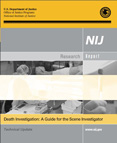|
|
||
|
JUNE 2015 | ||
|
Welcome to the June 2015 Crime Scene Investigator Network Newsletter
| ||
|
This Month's Featured Resource on the Crime Scene Investigator Network Website
|
||

Death investigation has evolved greatly in the years since the 1999 release of Death Investigation: A Guide for the Scene Investigator. This revised and updated edition is the result of a collaborative effort to present the most up-to-date information about the issues confronting death investigators today. The death investigator is the eyes and ears of the forensic pathologist at the scene. It is hoped that these guidelines, reflecting the best practices of the forensic community, will serve as a national standard. |
||
|
New CSI and Forensic Job Announcements
|
||
|
The most comprehensive listing of Crime Scene Investigation and Forensic To be notified of job openings as they are posted, follow us on Twitter: Job Posting Alerts |
||
|
Forensic Specialist (CSI/LPE)
Spokane County Sheriff, Spokane, Washington, USA Final Filing Date: June 12, 2015 Salary: $22.08 - $29.80 Hourly This is a technical, criminal identification position in the Spokane County Sheriff's Office. Individuals occupying this position perform extremely critical work in the identification of criminal offenders through the collection, preservation and evaluation of physical evidence obtained from crime scenes. <View complete job listing> |
||
|
Crime Lab Analyst — Digital Evidence
Florida Department of Law Enforcement, Tallahassee, Tampa, Florida, USA Final Filing Date: June 30, 2015 Salary: $40,948.18 - $75,649.72 per year Analysts in the Digital Evidence section conduct detailed laboratory examination and analysis of computer evidence involved in criminal cases at the request of law enforcement agencies. The results of these examinations are incorporated into written reports which form a basis for associated legal proceedings. <View complete job listing> |
||
|
Forensic Scientist I — Controlled Substances
Las Vegas Metro Police Department, Nevada, USA Final Filing Date: June 19, 2015 Salary: $29.36 - $43.45 Hourly Incumbents perform a variety of scientific laboratory examinations and analyses on physical evidence in controlled substances, interpret test results, formulate conclusions, and prepare reports. Incumbents also provide scientific assistance to external parties and testify in court as an expert witness. <View complete job listing> |
||
 |
||
|
Criminalist II — Latent Print Examiner
Rhode Island State Crime Lab, Kingston, Rhode Island, USA Final Filing Date: June 24, 2015 Salary: $56,286 - $71,038 per year Uses instrumental, physical and/or chemical techniques to examine a large variety of physical evidence submitted to the State Crime Laboratory by municipal, state and federal law enforcement agencies. Interpret results of analyses, prepare written reports and provide expert court testimony in the areas of friction ridge comparison and/or photography. <View complete job listing> |
||
|
Evidence Technician
Jupiter Police Department, Florida, USA Final Filing Date: June 14, 2015 Salary: $17.90 - $26.85 Hourly Maintain and process evidence seized from crime scenes, to include obtaining and securing evidence, processing evidence for fingerprints or DNA evidence, ensuring availability of evidence for subpoenas, and testifying in court and depositions. <View complete job listing> |
||
|
Research Officer — Forensic Computing
Bournemouth University, Talbot, UK Final Filing Date: 23 June 2015 Salary: £24,057 - £30,434 per annum An experienced software developer is sought to work on software for the analysis of three-dimensional footwear evidence at crime scenes. This exciting Natural Environment Research Council (NERC) Innovation Project is designed to translate research software developed for the analysis of fossil footprints into a practical application of use to both police forces and forensic services in the UK and overseas. <View complete job listing> |
||
|
Search for more job listings in Crime Scene Investigations and Forensics To be notified of job openings as they are posted, follow us on Twitter: Job Posting Alerts |
||
|
CSI in the News
|
||
|
Iowa State to be home to a new, $20 million national center for forensic science A Brand New Mobile Forensic Breakthrough Forensic photography, through a medical lens Bacteria on shoes could help forensic teams catch suspects Skull Fracture 'Prints' May Help Forensic Scientists Solve Child Abuse Cases |
||
|
Other Resources on the Crime Scene Investigator Network Website
|
||
|
Not Subscribed to this Newsletter?
|
||
|
If you are not subscribed to this newsletter, you may subscribe with this link: SUBSCRIBE via email |
||
|
To Unsubscribe
|
||
|
To unsubscribe from future e-mail newsletters, please click here: UNSUBSCRIBE Copyright ©2015 Crime Scene Resources, Inc. Crime Scene Investigator Network |


